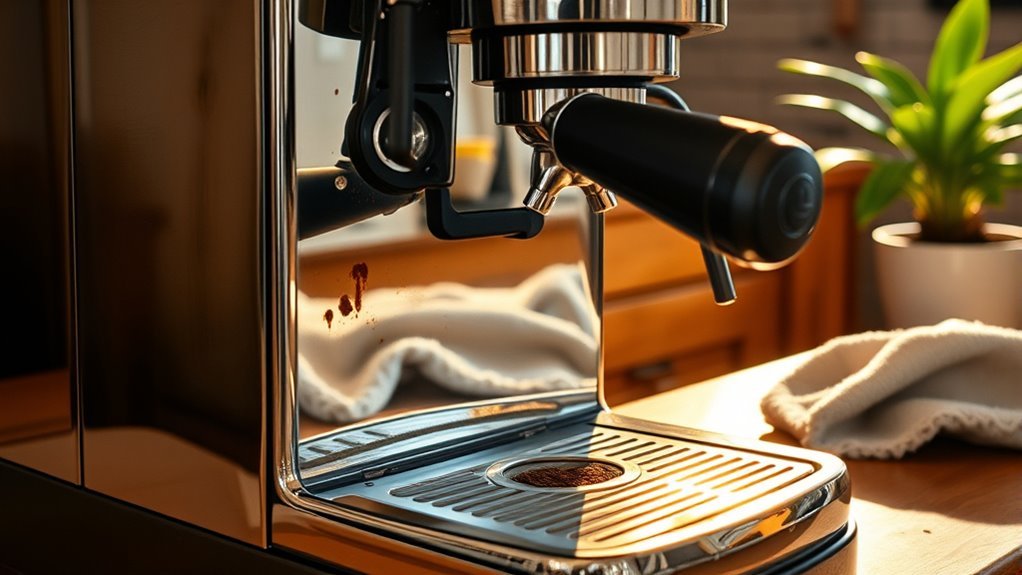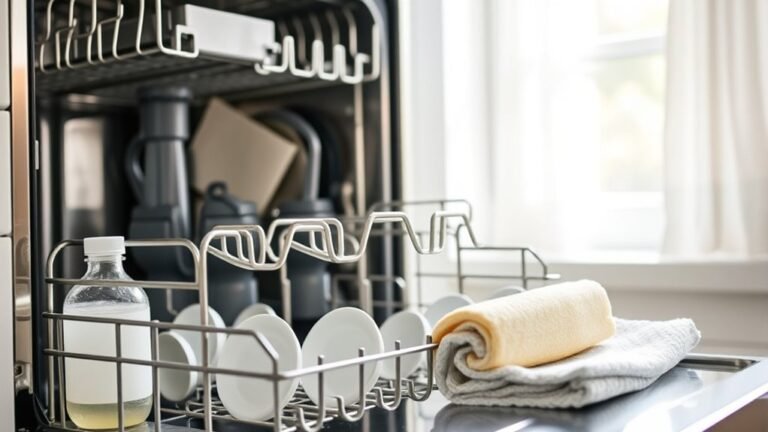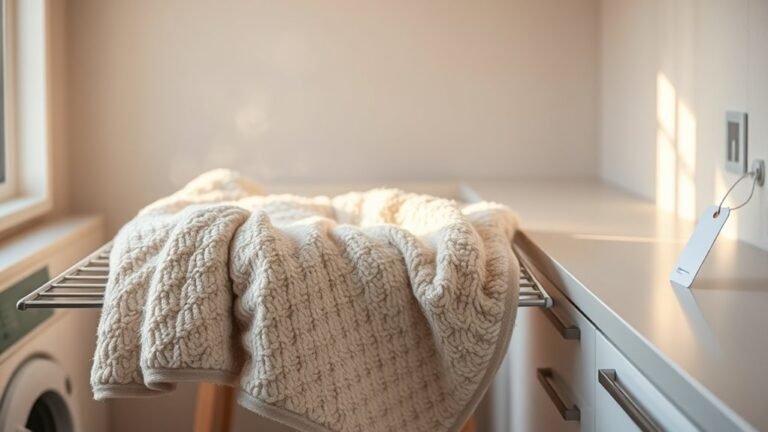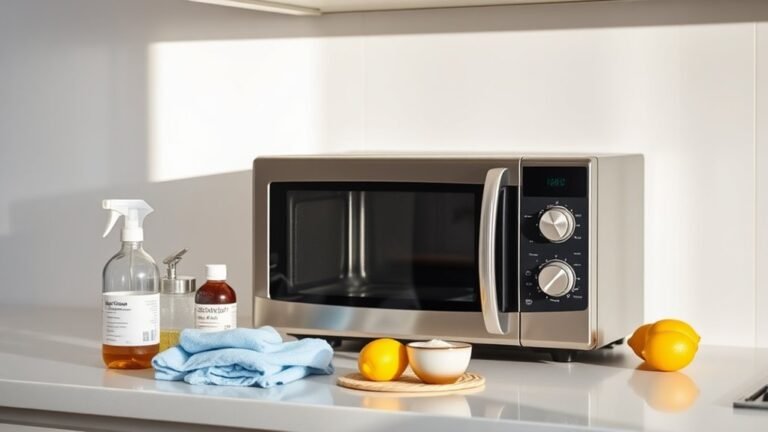Cleaning Tips Before and After Coffee Machine
Before brewing, verify your coffee machine’s components are clean, assembled correctly, and the water reservoir is filled with filtered water. Preheat it with a water-only cycle for ideal temperature. After use, unplug the machine, wash removable parts with mild detergent, rinse thoroughly, and wipe down surfaces to prevent residue buildup. Regular deep cleaning and descaling every 1-3 months help remove mineral deposits and maintain performance. Keep following for detailed steps to extend your machine’s lifespan and guarantee consistent brew quality.
Preparing Your Coffee Machine for Use
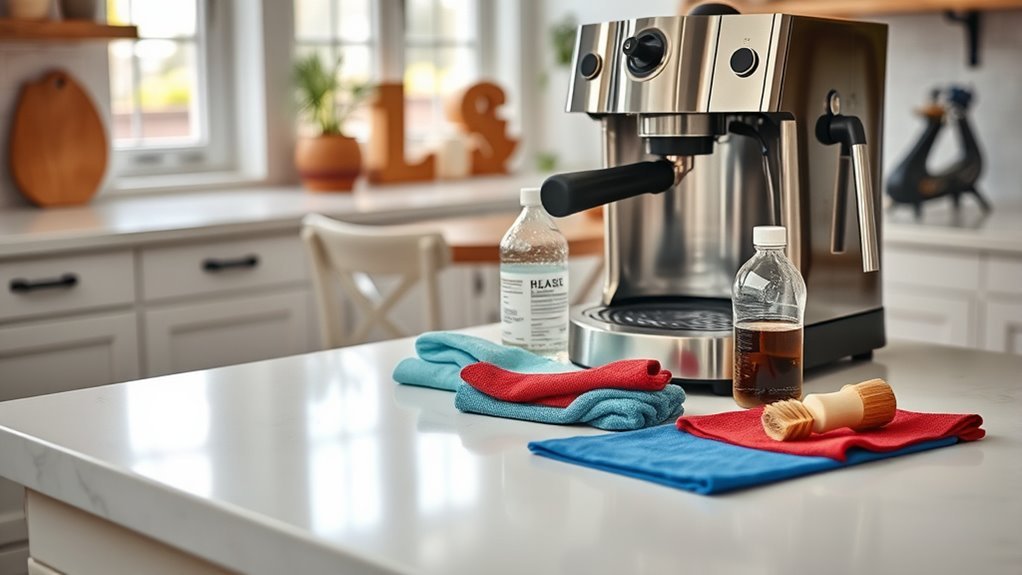
Before you start brewing, it’s essential to prepare your coffee machine properly to guarantee peak performance and flavor extraction. Begin by verifying that all components are securely assembled and free from residual debris. Pay particular attention to the filter basket, ensuring it’s clean and correctly positioned. Use freshly ground coffee grounds, measured precisely to your machine’s specifications, to optimize extraction. Equally critical is water quality; always fill the reservoir with filtered or bottled water to prevent mineral buildup that can impair heating elements and alter taste. Avoid using distilled water, as it may damage internal sensors. Preheating your machine by running a water-only cycle can stabilize brewing temperature. Regularly performing a descaling process helps maintain efficiency and ensures the best coffee flavor. These precise steps empower you to access the full potential of your coffee machine, delivering a consistent and flavorful cup every time.
Daily Cleaning Routine After Brewing
Although it may seem routine, performing a thorough daily cleaning immediately after brewing is crucial to maintain your coffee machine’s efficiency and flavor integrity. Start by unplugging the machine and removing all detachable parts. Using appropriate cleaning supplies, such as a soft brush and mild detergent, meticulously clean the filter basket, carafe, and water reservoir. Rinse each component with warm water to eliminate residue. Wipe the exterior and drip tray with a damp cloth. Follow a daily checklist to guarantee no step is missed, preventing buildup that compromises taste and function. Consistent daily maintenance reduces wear and tear, prolonging your machine’s lifespan. By adhering to this precise routine, you’ll enjoy superior coffee flavor and operational freedom without unexpected malfunctions. Additionally, disinfecting high-touch areas regularly ensures hygiene and preserves the quality of your brew.
Deep Cleaning Methods for Coffee Makers
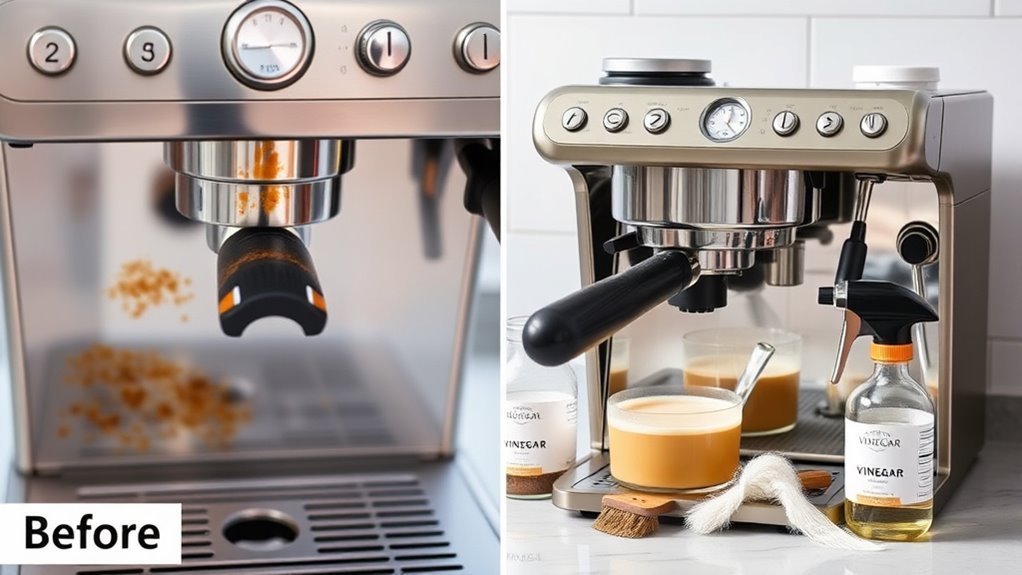
While daily cleaning keeps your coffee machine running smoothly, periodic deep cleaning is necessary to remove mineral deposits and stubborn residue that daily routines can’t address. Start by dismantling removable parts like the carafe, filter basket, and water reservoir. Soak these components in a carefully measured cleaning solution—preferably one designed to break down coffee stains without damaging materials. Use a soft brush or cloth to scrub crevices and eliminate buildup. For the machine’s interior, run a cycle with a mild, food-safe cleaning solution, then flush thoroughly with water to avoid residual taste. Pay special attention to the spray head and internal tubing, where residue accumulates invisibly. Performing these steps regularly guarantees peak performance, extends your machine’s lifespan, and preserves the freedom to enjoy clean, flavorful coffee every time. Additionally, regular maintenance practices such as wiping down seals and inspecting components can prevent buildup and ensure optimal operation of your coffee maker’s internal components.
Descaling Tips to Remove Mineral Build-Up
Since mineral deposits can greatly impair your coffee machine’s efficiency and flavor quality, descaling is an essential maintenance step. To effectively remove mineral deposits, you should:
- Choose descaling solutions compatible with your machine to avoid damage.
- Dilute the descaling solution according to manufacturer instructions for peak performance.
- Run the solution through a complete brewing cycle without coffee grounds to reach internal components.
- Rinse thoroughly by running multiple water-only cycles to eliminate residual descaling agents.
- Repeat descaling every 1-3 months depending on water hardness and usage frequency.
Following these steps guarantees mineral deposits don’t compromise your machine’s operation or coffee taste. Using proper descaling solutions preserves your freedom to enjoy high-quality brews without interruption.
Maintaining Your Coffee Machine for Longevity
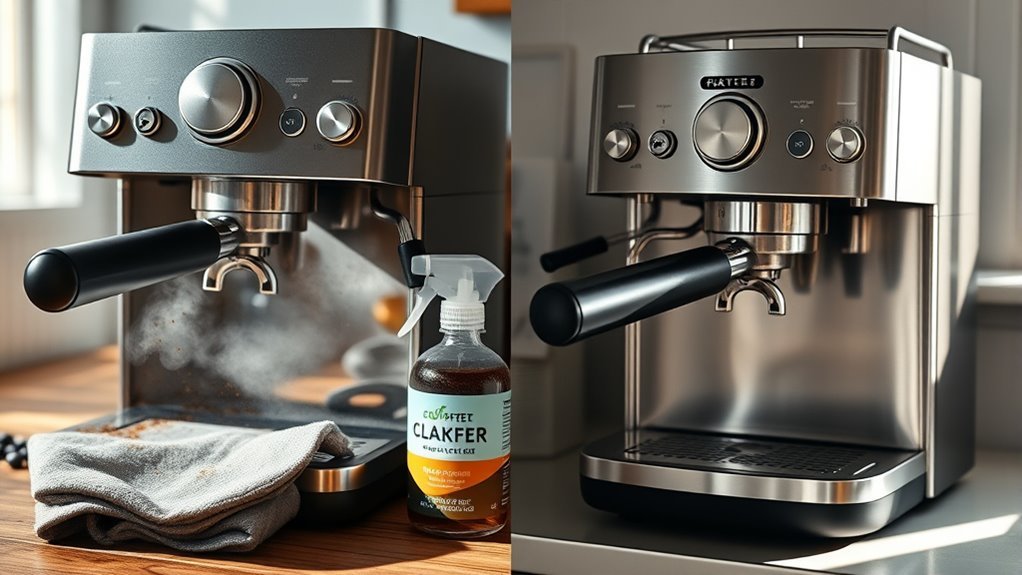
To guarantee your coffee machine delivers consistent performance over time, you’ll need to implement a routine maintenance schedule that addresses both mechanical and electrical components. Regularly clean internal parts, including the brew group and water reservoir, to prevent residue buildup that compromises coffee quality. Inspect seals and gaskets for wear, replacing them as needed to maintain ideal pressure and prevent leaks, which directly affect machine durability. Calibrate grinder settings periodically to ensure uniform grind size, enhancing extraction consistency. Flush the system with filtered water after each use to minimize mineral deposits and extend electrical component lifespan. Store your machine in a dry, dust-free environment when not in use to prevent corrosion. By following these precise actions, you’ll preserve both coffee quality and machine durability, granting you the freedom to enjoy perfect brews without interruption.
Frequently Asked Questions
Can I Use Vinegar Instead of Commercial Descaling Products?
You can use vinegar as a descaling alternative because of its natural acidity, which effectively breaks down mineral deposits. Vinegar benefits include being affordable and easily accessible, making it a popular choice for maintaining your machine. However, you should dilute it properly to avoid damaging internal components. While commercial descaling products are formulated for ideal safety and efficiency, vinegar offers a flexible, cost-effective option if used with care and precision.
How Often Should I Replace the Coffee Machine’S Water Filter?
Think of your water filter as the gatekeeper of purity, tirelessly guarding against impurities. To guarantee your coffee tastes its best, you should replace the filter every 2 to 3 months or after filtering about 40 gallons, depending on usage and water quality. Keeping to this maintenance schedule preserves the filter lifespan and prevents buildup, giving you the freedom to enjoy consistently fresh coffee without unexpected machine issues or degraded flavor.
Is It Safe to Clean the Coffee Machine With Bleach?
You shouldn’t clean your coffee machine with bleach directly because it can damage components and leave harmful residues. Instead, consider bleach alternatives like vinegar or specialized coffee machine descalers, which are safer and effective. If you must use bleach, follow strict safety precautions: dilute it heavily, rinse thoroughly multiple times, and guarantee no bleach smell remains before brewing. This approach protects your machine’s longevity and your health while maintaining cleaning freedom.
What’S the Best Way to Clean Reusable Coffee Pods?
To guarantee ideal reusable pod maintenance, you should clean your reusable coffee pods immediately after each use. Rinse them thoroughly with warm water to remove coffee grounds, then use a small brush to clear any residue from the filter holes. For deeper cleaning, soak pods in a mixture of water and vinegar weekly, rinsing well afterward. Maintaining this cleaning frequency prevents buildup, preserving flavor and extending pod lifespan, giving you freedom to enjoy fresh brews consistently.
Can I Run the Coffee Machine Without Coffee Grounds to Clean It?
Think of your coffee machine as a finely tuned instrument—you wouldn’t let it play off-key. Yes, you can run it without coffee grounds; this acts as a rinse cycle, flushing out residual oils and particles. For best machine maintenance, perform this cleaning step regularly—ideally after every 5-10 brews. This cleaning frequency guarantees your machine stays efficient and your coffee tastes fresh, giving you the freedom to enjoy every cup without compromise.
